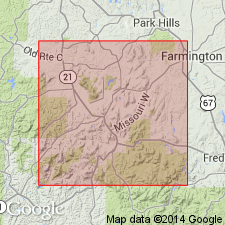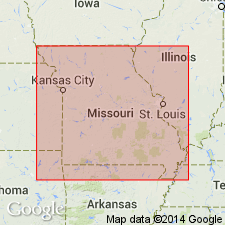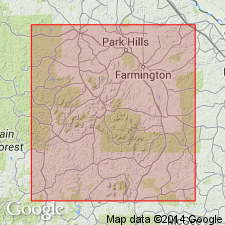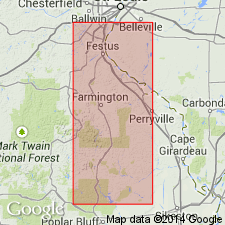
- Usage in publication:
-
- Hogan Mountain rhyolite
- Modifications:
-
- First used
- Dominant lithology:
-
- [Rhyolite]
- AAPG geologic province:
-
- Midcontinent region
Summary:
Hogan Mountain rhyolite (new) of Van East group (new). Briefly summarized in reports by W.C. Hayes, P.D. Procter, and J.A. Martin, p. 40, and W.C. Hayes, p. 83 (table 1), 85, this volume. New names are credited to Tolman and Robertson (in prep.) [1969, Missouri Div. Geol. Survey Water Res. Rpt. Inv., no. 44 (Contrib. to Precambrian Geol., no. 1)]. From 20 to 30 percent of rock consists of salmon-red feldspar with glassy quartz phenocrysts. Age is Precambrian.
Source: Modified from US geologic names lexicon (USGS Bull. 1350, p. 337).

- Usage in publication:
-
- Hogan Mountain rhyolite
- Modifications:
-
- Geochronologic dating
- AAPG geologic province:
-
- Midcontinent region
Summary:
Whole rock Rb-Sr age determined to be 1420 +/-30 m.y. Study area in St. Francois Mountains, southeast MO, Midcontinent region. Other units having same Rb-Sr age as Hogan Mountain include Royal Gorge rhyolite, rhyolite of Johnson Shut-ins, and Pilot Knob felsite. Older than Munger granite porphyry and Magee granite (1260 +/-30 m.y.) and Stout's Creek rhyolite (1315 +/-35 m.y.). Age similar to Silvermine and Butler Hill granites (1400-1450 m.y.).
Source: GNU records (USGS DDS-6; Denver GNULEX).

- Usage in publication:
-
- Hogan Mountain rhyolite
- Modifications:
-
- Principal reference
- Dominant lithology:
-
- Rhyolite
- AAPG geologic province:
-
- Midcontinent region
Summary:
Hogan Mountain rhyolite of Van East group. Typically a red to reddish-purple color. Contains salmon-red feldspar and glassy quartz phenocrysts. Is similar to middle unit of Stouts Creek rhyolite of Van East group; differs by its persistent attitude of flow structure, more abundant phenocrysts, and reddish color. Age is Precambrian.
Named from exposures on northeast slope of Hogan Mountain, in sec. 22, T. 33 N., R. 3 E., Iron Co., southeastern MO.
Good exposures seen on Bell, Goggins, Lee, Little Taum Sauk, Russell, and Taum Sauk Mountains, in St. Francois Mountains, southeastern MO. (Type locality not designated.)
[GNU remark (Feb. 16, 1990, USGS DDS-6; Denver GNULEX): Thickness not discussed; stratigraphic relationships of units of Van East not discussed in text; geologic map (plate 1) missing from library copy of report.]
[GNC remark (February 29, 2008): It appears that †Hogan Mountain rhyolite of †Van East group has not been applied to these rocks since this publication. Considered abandoned.]
Source: Modified from GNU records (USGS DDS-6; Denver GNULEX).

- Usage in publication:
-
- Hogan Mountain Rhyolite
- Modifications:
-
- Geochronologic dating
- AAPG geologic province:
-
- Midcontinent region
Summary:
Rb-Sr data on whole rock samples of Unit 810 of Berry (1970, unpub. thesis, Univ. Kansas) yields an age of 1346 +/-31 m.y. Unit 810 includes Hogan Mountain and Royal Gorge Rhyolites. Rb-Sr data probably underestimates actual age; low age probably due to Sr loss. Samples taken in T33N, R2E, Reynolds Co and T33N, R3E, Iron Co, MO, Midcontinent region (specific localities listed in appendix 3). Analytical data in appendix 4.
Source: GNU records (USGS DDS-6; Denver GNULEX).

- Usage in publication:
-
- Hogan Mountain Rhyolite
- Modifications:
-
- Not used
Summary:
Hogan Mountain Rhyolite. Not used in western St. Francois Mountains, southeast Missouri (Midcontinent region). Nomenclature of Tolman and Robertson (1969) revised because of better understanding of regional structure and recognition of individual units consisting of ash-flow tuffs, air-fall tuffs, lava flows, and mixtures of these. Replaced with newly named formations (alphabetical): Bell Mountain Rhyolite (Bell, Lee, North Bell, and Wildcat Mountains); Johnson Shut-ins Rhyolite (swimming area of Johnson Shut-ins State Park); Lindsey Mountain Rhyolite (North Bell Mountain); Proffit Mountain Formation (south end of Johnson Shut-ins); Royal Gorge Rhyolite (Royal Gorge area, and Crane, Lee, Proffit, and Taum Sauk Mountains); Russell Mountain Rhyolite (Bell, Lee, and North Bell Mountains); Taum Sauk Rhyolite (Goggins, Hogan, Lee, Proffit, Taum Sauk, and Wildcat Mountains); and Wildcat Mountain Rhyolite (Bell, Lee, North Bell, and Wildcat Mountains).
Source: Modified from GNU records (USGS DDS-6; Denver GNULEX).
For more information, please contact Nancy Stamm, Geologic Names Committee Secretary.
Asterisk (*) indicates published by U.S. Geological Survey authors.
"No current usage" (†) implies that a name has been abandoned or has fallen into disuse. Former usage and, if known, replacement name given in parentheses ( ).
Slash (/) indicates name conflicts with nomenclatural guidelines (CSN, 1933; ACSN, 1961, 1970; NACSN, 1983, 2005, 2021). May be explained within brackets ([ ]).

